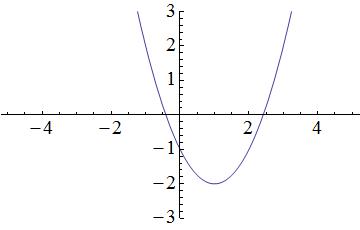All College Algebra Resources
Example Questions
Example Question #1 : Graphing Polynomials
How many zeroes does the following polynomial have?







If we try the next number up, 3, we get this:


and now we need to see if 
There aren't any real numbers that square to get -5 so this has no roots. Thus, 
Example Question #2 : Graphing Polynomials



True or false: By the Intermediate Value Theorem, 

True
False
False
As a polynomial function, the graph of 




Set 





Both are polynomial graphs fitting the given conditions, but the only the equation graphed at right has a zero on 
Example Question #241 : College Algebra
True or false:
The polynomial 

False
True
True
One way to answer this question is as follows:
Let 



as its coefficient sum, so 

Example Question #5 : Graphing Polynomials
True or false:
The polynomial 

False
True
False
Let 


To find this alternating sum, it is necessary to reverse the symbol before all terms of odd degree. In 


so 

Example Question #5 : Graphing Polynomials



True or false: By the Intermediate Value Theorem, 

False
True
True
As a polynomial function, the graph of 




Setting 








Example Question #7 : Graphing Polynomials
Let 

True or false: It follows that 

True
False
True
By the Factor Theorem, 













Example Question #1 : Graphing Parabolas
Which of the following graphs matches the function 






Start by visualizing the graph associated with the function :

Terms within the parentheses associated with the squared x-variable will shift the parabola horizontally, while terms outside of the parentheses will shift the parabola vertically. In the provided equation, 2 is located outside of the parentheses and is subtracted from the terms located within the parentheses; therefore, the parabola in the graph will shift down by 2 units. A simplified graph of looks like this:

Remember that there is also a term within the parentheses. Within the parentheses, 1 is subtracted from the x-variable; thus, the parabola in the graph will shift to the right by 1 unit. As a result, the following graph matches the given function :

Example Question #1 : Finding Roots
Find the roots of the function:
Factor:
Double check by factoring:
Add together:
Therefore:
Example Question #1 : Finding Zeros Of A Polynomial
Solve for x.
x = –4, –3
x = 5
x = 4, 3
x = –5, –2
x = 5, 2
x = 5, 2
1) Split up the middle term so that factoring by grouping is possible.
Factors of 10 include:
1 * 10= 10 1 + 10 = 11
2 * 5 =10 2 + 5 = 7
–2 * –5 = 10 –2 + –5 = –7 Good!
2) Now factor by grouping, pulling "x" out of the first pair and "-5" out of the second.
3) Now pull out the common factor, the "(x-2)," from both terms.
4) Set both terms equal to zero to find the possible roots and solve using inverse operations.
x – 5 = 0, x = 5
x – 2 = 0, x = 2
Example Question #322 : Intermediate Single Variable Algebra
Solve for 
To solve for 

Next, you can factor out this quadratic equation to solve for 
Finally, you set each binomial equal to 0 and solve for 
Certified Tutor
All College Algebra Resources










































